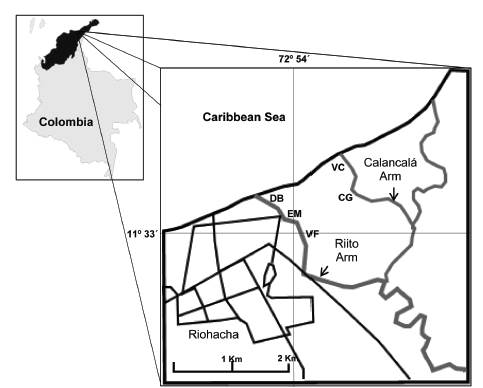INTRODUCTION
The physicochemical variables in the estuarine systems are among the most important factors in the spatio-temporal dynamics of these ecosystems [1], the contact of the inland waters with the marine waters is a great instability in the physicochemical conditions, mainly in the salinity [2].
The delta of the Rancheria River, is an estuarine system that does not escape to these special conditions which favor the development of the biota, mainly represented by mangroves bordering [3]; these water bodies are highly productive, and important to the ecology of the ecosystem [4]; bearing different biological groups ranging from the microalgae until the fish [5, 6, 7].
The delta of the Rancheria River is represented by two arms or slopes, the Riito and Calancalá, which have different degrees of anthropic influence along its course, represented in the negative effects of deforestation and inappropriate land use [7]. The constant monitoring of the spatio-temporal dynamics of water bodies is necessary for the interpretation and understanding of the effects of climate change on the water dynamics and its relationship with the use of the resource, primarily the relationship with the high human population growth [8, 9], and what this means in terms of greater demand for resources, generating greater changes in ecosystems.
Approximately 61 % of the world population is within or close to an estuary, still evident that demographic changes influence the estuaries and can cause negative effects on biogeochemical cycles within these aquatic systems, resulting in a notorious eutrophication excessive [10]. The period of the present study (2014 - 2015), was characterized by being under the influence of a strong dry product of the El Niño phenomenon (Southern Oscillation), appearing as one of the driest years in which they have historical record in Panama [11], a neighboring country of Colombia.
The above supports the need to characterize, evaluate and monitor the aquatic systems that support ecological and socio-cultural, mainly those related to the delta of the Rancheria River, in the Colombian Guajira, zone that is in growing socio-economic development and that demand studies on the spatiotemporal dynamics of the physicochemical variables related with the water resource in the Delta of the Rancheria River, to the generation of information, input basis for decision-making and status of this ecosystem, response to the different shocks.
MATERIALS AND METHODS
The study area
The delta of the Rancheria River is located between 11° 33' and 72° 54' N and 11° 33' and 72° 53' W, characterized by a branch that results in two arms or slopes, known as El Riíto and Calancalá, which are separated by an average distance of two kilometers away; flow into the Caribbean Sea and presented an approximate area of 332.84 ha. Stripes are observed joint mangrove represented mostly by three species, Rhizophora mangle L. , Avicennia germians L. and Laguncularia racemosa L. [3]; the average temperature of 27 oC is relatively stable, little variable throughout the year [12]; of the arms that make up the delta, the principal is the Riíto, which is associated to the urban center of Riohacha, along its slope, mainly in the rainy season, flow into the 13 sewers, while the arm Calancalá is associated with the indigenous village Cangrejito toward its southern portion [3]. It is stressed that the depth does not exceed the two meters along the delta of the Rancheria River.
Set up five sampling stations in the delta of the Rancheria River, three corresponding to El Riíto arm, called Desembocadura (DB) located at the geographic coordinates of 11°33'14.60" N - 72°54'8.80" W, El Mirador (EM) in the 11°33'9.00" N - 72°54'4.10" W and Villa Fatima (VF) positioned at 11°33'0.80" N - 72°53'51.70" W; in addition to two stations for the arm Calancalá, represented by Cangrejito (CG) located in the 11°33'36.10" N - 72°53'25.10" W, and Valley of the Crabs (VC) to the 11°33'36.00" N - 72°53'25.50" W (Figure 1).
Field work
Monthly samplings were carried out between September of the year 2014 and August 2015, getting information about the physicochemical variables in the periods of rain and dry, according to their determination the records of precipitation, at the level of the area of study, supplied by the Institute of Hydrology, Meteorology and Environmental Studies of Colombia (IDEAM), which presents the rainy period related to the months of September 2014 - January 2015 (assuming as rainy season the continuous months where there was a minimum of precipitation) and the dry period at the interval February 2015 - August 2015 (Figure 2).
The monitoring of the physicochemical variables selected for the study was in situ, by means of precision equipment specific and calibrated for each variable, with the aim of obtaining a better approach to the dynamic behaviour of these in each monitoring station; the temperature (oC.), salinity (ups.) and pH was recorded by means for these variables with a multi-measurement device (trademark 315i WTW 1,210 00 11), the dissolved oxygen (mg./L.) was determined with a oximeter (trademark 315i WTW 2B70 0011) and turbidity (ntu.) by the nephelometric method (SM 2130 B, APHA [13]). Also, water samples were taken in amber color glass bottles of 1 L capacity, previously sterilized, labelled and lined with aluminum foil and then refrigerant in a fridge of icopor (~6 °C.) to determine in the laboratory other parameters of chemical nature.
Laboratory work
In the laboratories of the Institute of Studies and Development of Water (INESAG) of the University of La Guajira was determined the Total Hardness (mg./L. CaCO3) and alkalinity (mg./L. CaCO3), in addition to the concentrations of nutrients: ammonium (mg./L.), nitrate (mg./L.), nitrite and total phosphorus (mg./L.) following the methodology established by APHA [13]. It was also established the relationship nitrogen/ phosphorus (N/P).
Statistical analysis
For the analysis of the results is using the tools of descriptive statistics that allow to observe the behavior of the variables, (average, standard deviation, minimum and maximum) as well as evidence that would allow the analysis of differences in the behavior of the variables between the monitoring stations in relation to the seasons, to such effect was used the Kruskal-Wallis test (as it does not meet the parametric assumptions of normality and variances homogeneity), carried out with the program Statgraphics Centurion XV version 15.2.06.
RESULTS
Temperature
The average water temperature recorded in the two climatic periods not presented significant differences (Kruskal-Wallis p>0.05) between the stations, (Table 1 and 2). It is noted that the associated stations to arm the Riito (DB, EM and VF), presented higher temperature averages in the two climatic periods, rains and dry.
Table 1 Averages and intervals (minimum - maximum) of physical-chemical variables in the water during rainy season (September 2014-january 2015 period) in the studied stations in the Rancheria River Delta.
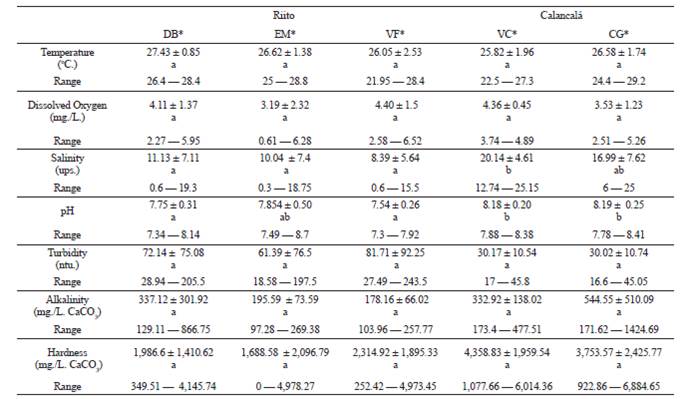
Different lowercase letter indicated significant differences (p<0.05). DB: Desembocadura / EM: El Mirador / VF: Villa Fátima / VC: Valle de los Cangrejos / CG: Cangrejito *=Average ± Standard Deviation.
Table 2 Averages and intervals (minimum - maximum) of physical-chemical variables in the water during dry season (February 2015-august 2015 period) in the studied stations in the Rancheria River Delta.
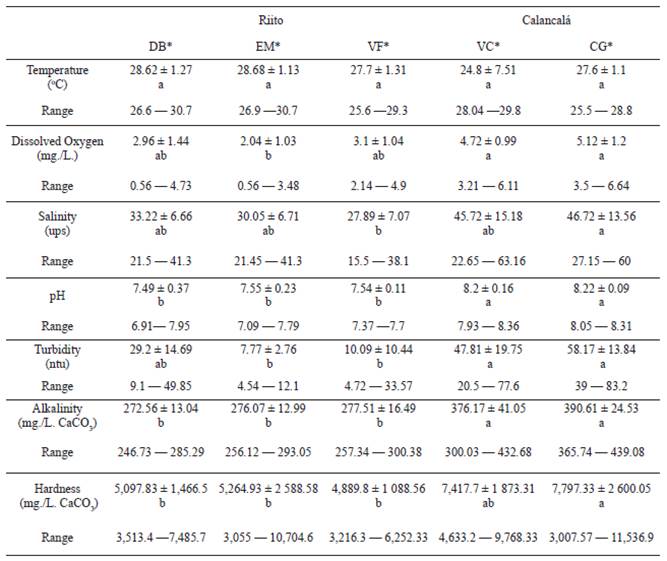
Different lowercase letter indicated significant differences (p<0.05). DB: Desembocadura I EM: El Mirador I VF: Villa Fátima I VC: Valle de los Cangrejos I CG: Cangrejito *=Average ± Standard Deviation.
Dissolved oxygen
For the rainy season the values of oxygen does not show significant differences (p>0.05) between the stations studied in both arms of the delta (Table 1), however, the lowest oxygen value (0.61 mg./L.) was recorded at the station El Mirador (EM), associated to arm the Riito in the month of September 2014. For the dry season, the values of this parameter were greater in the associated stations to arm Calancalá, however, are only significant differences (Kruskal-Wallis p<0.05) between the stations of the arm Calancalá and the station El Mirador of El Riito Arm.
The Arm El Riito stations decreased their average concentrations of oxygen of the rainy season to dry while in the stations of the arm Calancalá happens the contrary, the dissolved oxygen average increases between the period of rain to dry (Table 1 and 2).
Salinity
This parameter presented a significant variability (Kruskal-Wallis p<0.05) for both climatic periods in the delta of the Rancheria River, for the rainy season it was noted a trend of lower salinity at the level of the stations DB, EM and VF (Arm The Riito) with regard to VC and CG (Arm Calancalá), is observed in the first a field of 0.6 - 19.3 ups. (Table 1) , while the latter an area of 6 - 25.15 ups. Registers progressive increase in stations studied in the Rancheria River, already for the dry period salinity levels reach high values between 60 and 63.16 ups. for stations CG and VC respectively, in the last months of study, being these stations presented the highest values of salinity for the entire study (Table 2) . By the other hand, the stations of the arm El Riito, recorded maximum salinity values that reach 41.3 ups. Independently for each arm and the broad lines of the salinity decreased from the nearest stations to the sea until the most distant from it, following the typical pattern of a deltaic estuary.
pH
The values of the concentration of hydrogen ions at the level of the pH scale showed significant differences (Kruskal-Wallis p<0.05) between the stations associated with the arms of the Riito and Calancalá during the two periods studied; it is evidenced that the arm Calancala presents pH values above to arm the Riito, in the rainy season (Table 1) as in the dry period (Table 2), observing the tendency to present alkaline waters along the area of study.
Turbidity
Only significant differences were observed in the turbidity (Kruskal-Wallis, H=0.08 p=0.00) between the stations during the dry season (Table 2). The turbidity values show a different dynamic for each one of the arms of the estuarine system of the Rancheria River, for the arm El Riíto highlights the fact that the mean values of this variable decrease in relation to the period of rains with the dry period, where for example the DB station with an average of 72.14 ntu. during the rainy period (Table 1), showed an average of 29.2 ntu. in the dry period (Table 2), while in the arm Calancalá both stations have records of turbidity with tendency to increase (30.17 and 30.02 ntu. for VC and CG, while 47.81 and 58.17 ntu. for the same stations respectively, during the transition from rainy to dry). The results allow interpreting that the waters of the arm Calancalá are more unclear than the waters of the Riíto, mainly during the dry season.
Alkalinity
The values of alkalinity during the rainy season are recorded relatively higher in the stations VC and GC in comparison with DB, EM and VF, however no significant differences were observed (Kruskal-Wallis, H=6.21, p=0.18) between the stations with respect to this variable (Table 1). On the other hand in the dry season, significant differences were observed (Kruskal-Wallis, H=24.27, p=0.00) that separate stations VC and CG of the rest of the stations studied, in other words the two arms of Delta of Rancheria River are different in regard to the alkalinity, where the arm Calancalá presents average values of alkalinity above 300 mg. CaCO3 for this period, while the average values for the stations associated with the Riito are minors (Table 2), so that it can be interpreted that the waters of the arms of the delta of the Rancheria River have different buffer capacities.
Hardness
The general trend of the hardness of the water in the area of study is to increase the period of rains to the dry period in all stations studied, although no significant differences were observed (Kruskal-Wallis, H=0.88, p=0.17) during the rainy season; not so with the dry season (Kruskal-Wallis, H=10.31, p= 0.035), where the station CG (Calancalá) is distinguished from the associated stations to El Riíto, presenting an average value of 7,797.33 mg./L. CaCO3, registering a maximum value of 11,536.9 mg./L. CaCO3 in August 2015.
Ammonium: for the rainy season is observed the lowest values average ammonium for all seasons studied, without showing significant differences (Kruskal-Wallis, H=1.7, p=0.79) between them (Table 3). During the dry season the lower values average ammonium observed in the stations VC and CG for the Calancalá arm, with values of 0.027 and 0.018 mg.IL. respectively, while the minimum average value for the stations of El Riíto is represented by 0.19 mg.IL. in the station EM.
Table 3 Averages and intervals (minimum - maximum) of nutrients in the water during dry rainy season (September 2014-january 2015 period) in the studied stations in the Rancheria River Delta.
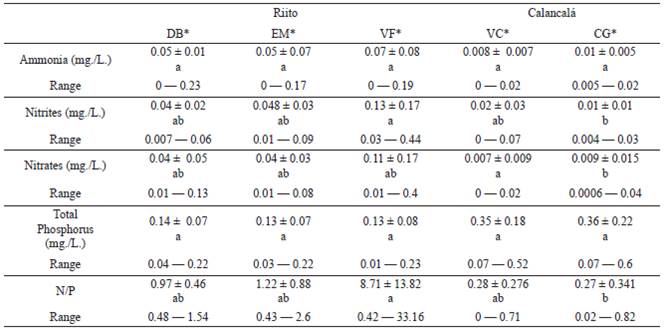
Different lowercase letter indicated significant differences (p<0.05). DB: Desembocadura I EM: El Mirador I VF: Villa Fátima I VC: Valle de los Cangrejos I CG: Cangrejito*=Average ± Standard Deviation.
Significant differences were observed (Kruskal-Wallis, H=23.95, p=0.00) between the stations, which basically allow separate the VF station of the associated stations to arm Calancalá in relation with the Ammonium (Table 4).
Table 4 Averages and intervals (minimum - maximum) of nutrients in the water during dry season (february-august 2015 period) in the studied stations in the Rancheria River Delta.
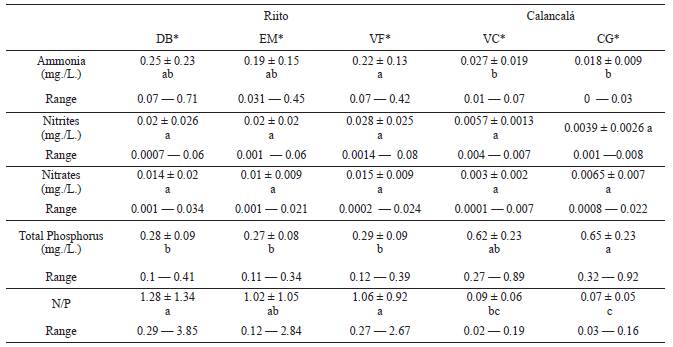
Different lowercase letter indicated significant differences (p<0.05). DB: Desembocadura / EM: El Mirador / VF: Villa Fátima / VC: Valle de los Cangrejos / CG: Cangrejito*=Average ± Standard Deviation.
Nitrite
It was observed a tendency of a decrease of the concentration of nitrites of the rainy season to the dry period in all the seasons; during the rainy season the greatest average value is in the station VF (0.13 mg./L.), being statistically different (Kruskal-Wallis, H=9.66, p=0.046) of the station CG, which presented a value lower than average (0.01 mg./L.) (Table 3). For the dry period, no differences have been observed (Kruskal-Wallis, H=9.31, p=0.054) between the stations. However, the lower average concentrations were found in VC and GC with 0.0039 and 0.0057 mg./L., respectively (Table 4).
Nitrates
Presents a similar dynamic to the concentration of nitrites, there is a tendency to reduce the concentration of nitrate during the change of the rainy season to the dry period. Significant differences were observed (Kruskal-Wallis, H=9.97, p=0.04) in the rainy season between the two stations associated with the arm Calancalá (Table 3). During the dry season is not present significant differences (Kruskal-Wallis, H=6.62; p=0.15) between the stations, however the lowest average values are found in the VC stations and CG Calancalá arm (Table 4).
Total Phosphorus
The average concentrations of total phosphorus increase in all stations during the transition of the rainy season to the dry period, no statistically significant differences were found (Kruskal-Wallis, H=8.17, p=0.08) between the stations studied during the rainy season. For the dry period the largest average values were observed in the stations VC and GC with 0.62 and 0.65 mg./L., respectively, although significant differences were found (Kruskal-Wallis, H=18.85; p=0.000) that separate the station CG partner stations to arm El Riíto.
Relation N/P
This relationship allows to observe the dynamics of these two nutrients in their spatio-temporal dynamics, recording average values higher than one (1) in the stations EM and VF while below one (1) in the rest of the stations, indicating that the levels of total nitrogen are above the total phosphorus in the first. There is evidence that the lowest values are associated to the stations VC and CG Calancalá arm, presenting significant differences (Kruskal-Wallis, H=13.71, p=0.008) between the stations CG and VF, this last of the Riíto arm, which obtained an average value of 8.71 mg of N by mg. P, with a maximum of 33.16 mg. of N by mg. P, in the month of October 2014 (Table 3). During the dry season are significant differences (Kruskal-Wallis, H=23.87, p=0.00), that separate stations VC and CG (Calancalá).
The lower average values of this relationship are found in the stations DB and VF (Riíto). It is stressed that this relationship was below one in most of the months of dry studied at the stations of the arm The Riíto (DB, EM and VF) and that the average value is influenced by the values obtained during the months of February, March and April 2015, whose values are above one in those stations and the maximum values observed are all consistent with the month of April 2015.
DISCUSSION
The temperature is not significantly different between the stations during the periods studied, however it is stressed that the study period (September 2014-August 2015) corresponds in part to the warmest period which has historical record at the global level, as well as also registers the effects of El Niño, Southern Oscillation [11], which has among its effects severe dry [14].
The variable that evidence greater relation with the climatic effects is perhaps the salinity, which was gradually increasing during the study period, showing statistically significant differences between some sampling stations during both climatic periods, however from a perspective between the arms of the delta of the Rancheria River significant differences were observed (p<0.05) in the dynamics of the salinity between the Arm The Riíto and Arm Calancalá (Figure 2), introducing less saline the first with regard to the second during both periods.

Figure 2 Salinities in the arms of the Ranchería River delta in the rainy season (A) and the dry season (B). Different lowercase letters indicate significant differences between arms (Sample sites) at 95% confidence interval (p<0.05).
The increase in the salinity in both arms explains from two approaches, the first is the formation of a bar that cut off the mouth of both arms with the Caribbean Sea from February 2015, while the second is the coincidence of that month with the beginning of the dry period, which can be considered atypical, in view of the fact that there is not a bimodal rainy and dry season as is characteristic in the area [15], contrasting this with the precipitation data of the study period (Figure 2), it is inferred that the evaporation exerted a strong influence on the Delta and leads to the increase of the records of salinity.
This influence climate, in addition to particular characteristics of the sampling points and even each arm of the delta of the Rancheria River, presented a dynamic that difference an arm with respect to another level of the physicochemical parameters. For its part the oxygen showed no differences between the stations during the period of rains, however in the dry period if was observed, mainly at the station El Mirador (EM), highlighting lower concentrations of this variable at the level of the stations of the Riíto arm, and that may be due to the discharge of wastewater from the villages associated with this arm, which bring excess of organic matter which by the action of the microbial decomposition causes the decline of oxygen [2]. The above, can also explain the decrease in oxygen concentrations, in relation of the rainy season to the dry period, while the opposite happened in the arm Calancalá, which may be related to the direct relationship to the town, due to that it presents no major towns partners, the organic load is nature mainly, that although there may be a great productivity related with the litterfall of mangroves adjacent to this system[15], it is not comparable with the anthropic influence evidenced in El Riíto.
The pH levels may be noted higher in the Calancalá arm with respect to the Riíto arm, which can be the answer to the marine influence in the first, translated into higher salinity, as well as in greater total hardness and even increasing alkalinity, which is directly related with the pH, and the system of carbonates [2], by which it is to be expected higher levels of pH, to find higher levels of total hardness and alkalinity, even when only significant differences were observed between the stations at the level of the dry period, this mainly due to the fact that during the rainy season there was greater influence of tides, before the formation of the bar, as well as greater influence of precipitation at the level of the River discharge, which led to a dynamic much more mixed in both arms.
On the other hand, the turbidity registers an inverse dynamics in both arms, since the stations associated with the Riíto diminish their turbidity of the rainy season to the dry period, while the opposite to the arm Calancalá, this dynamic is explained in the same sense of the anthropic influence associated to arm the Riíto, which generates unloading of materials in suspension in excess [3], as well as the same hydrodynamic download; while the arm Calancalá increases its turbidity probably by effect of the hyper-salinity, which in turn can lead to greater litterfall [15], which also leads perhaps to higher levels of tannins dissolved in the water [10]. In view of the foregoing, may also be inferred that both arms presents different hydrodynamics in the delta, especially at the level of the rainy season, as indicated Polanía et al. [3].
The dynamics of the nutrients are notes option between the arms and periods, for ammonium the difference between stations presented in regard to this variable during the dry season, can be the answer to El Riito, where the concentration of ammonium was greater, the organic load extra product of human activities, provided larger amounts of this type of material, in addition that can be influenced by the flow in this arm is higher in relation to the arm Calancala [3]. The increase of ammonia in the rainy period with regard to the dry period is explained by the accumulation of organic material downloaded by the waters of the River, as well as the effect of increasing the concentration of this nutrient by effect of the evaporation, stressing that the eutrophic systems favor the flow of ammonium [10].
The ammonium and nitrate are the forms more assimilated of nitrogen by the primary producers [2], during the rainy season is taken advantage of higher way, especially in estuarine conditions where the salinity can generate a stress, becoming a limiting factor for several organisms. Have been found different patterns in terms of the dynamics of ammonium, such as records of Noriega et al. [16], who reported lower levels of ammonia during the dry season, so it is important to highlight the complexity of the estuarine ecosystems and the dynamics of nutrients is dependent on many factors ranging from the natural to the anthropogenic.
The nitrate to be another of the more assimilated forms of nitrogen from the agencies autotrophs, presents a different behavior with respect to ammonium, due to decreased concentrations of the rainy season to the dry period, in both arms, as well as highlights that significant differences are found between stations during the rainy season, mainly between the arms; both phenomena can be explained by the river discharge, which pulls the organic material associated with urban areas and even agricultural and farming upstream, bringing with compounds such as fertilizers among others[10], just as there are differences of the download hydrodynamic product between the arms of the delta of the Rancheria River, this being higher at the level of The Riíto in comparison with the arm Calancalá [3], by which it is to be hoped lower concentrations where the download is less.
The dynamics of the nitrogen cycle and its dependence on the microbial processes, explain in large part the fluctuations of the forms of nitrogen between the seasons, as well as other environmental factors such as carbon content, depth of water, oxygen, temperature between other [10]. In fact, the tannins of mangroves (R. mangle) presented a very high reactivity, which influences preserve organic nitrogen and the damping of the nitrogen cycle in estuarine ecosystems, preventing the rapid export and loss of dissolved organic nitrogen [17], which could also be influencing the dynamics of nitrogen mainly in the arm Calancalá.
The excesses of organic matter in the sediments, favor the flow of ammonium from these to the water column, with moderate flows of nitrate and nitrite [10], this could explain in part the results found in this study at the level of the dry period, where ammonium occurs in higher concentrations with respect to the other forms of nitrogen (nitrate and nitrite). In the arm Calancalá it is likely that the ammonium this was assimilated mostly by phytoplankton present in its waters, which explains, lower concentrations of this element with respect to arm the Riíto, as well as greater turbidity and dissolved oxygen during the dry period.
In other areas of the Colombian Caribbean has found a similar pattern in the dynamic of the nutrient nitrogen, where ammonium is the main composed of this type, as well as a relative increase in the processes of eutrophication [18]. Equally, Muñoz [19], reported increases in phosphorus and ammonium in consequence of the accumulation of organic matter in an estuary of the Iberian Peninsula (Spain).
For its part the phosphorus presents higher concentrations in the arm Calancalá, which may be due to a greater presence of vegetable in this arm and the gradual increase in the salinity which could lead to increased contributions of litter, therefore higher contribution of allochthonous organic matter in the system, which are one of the main sources of phosphorous [10, 20]. It also points out that the phytodetritus can increase the flow of phosphorus from the sediments to the water column (at least the closest to the Fund), dependent in turn of the oxygen concentrations, which if are low favor exports from sediments [10]. However, the arm Calancalá presents higher concentrations of oxygen, so perhaps the exports of phosphorus could occur at night where the breath exceeds to photosynthesis [20]. It is important to mention that in this work we evaluated the total phosphorus, so that the organic load present in the water brings an important fraction to the amount of phosphorus, with respect to the forms inorganic.
The relationship N/P of Redfield (16/1) in estuaries tends to break, either in favor of nitrogen or phosphorus [10, 19], which the present study also corroborates; in this case the phosphorus was slightly higher than the nitrogen in most of the months and sampling stations so that this was the limiting factor in the greater part of the period of sampling; Muñoz [19] reported values of N/P in favor of phosphorus, in areas where it presented greater marine influence (presence of saline wedge), so that this type of waters can promote the increase of phosphorus, mainly by the contributions of the litter organic product that could explain the high concentrations of phosphorus (mainly particulate) in the dry season and specifically in the arm Calancalá.
Compared with other tropical estuaries, the Delta of Rancheria River presents a great different, because the temporal seasons are very modelers of the estuary morphology, mainly to the bar formation in the coast zone (High evaporation and low rainfall). Other estuaries present greater areas of drainage and amplitude [16], different morphology [1], and even other classification like coastal lagoons [18]. The temporal differences in the tidal and rainfall regime, is the major causes of variability in this environments [10].
CONCLUSIONS
The delta of the Rancheria River presented a very marked variability in space-time in the arms that comprise it, product of natural and artificial factors; during the period of study the climatic factor was very influential, mainly the effects of precipitation and evaporation, also the anthropogenic interventions are presented as molders of the dynamics of the physicochemical variables in this estuarine system.













